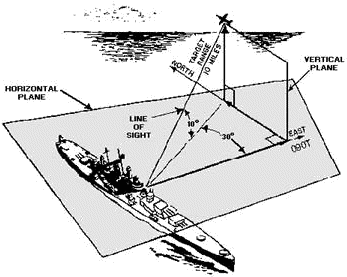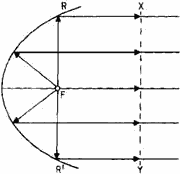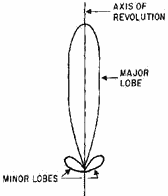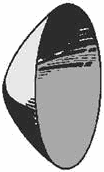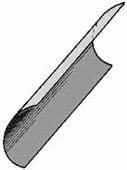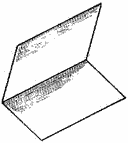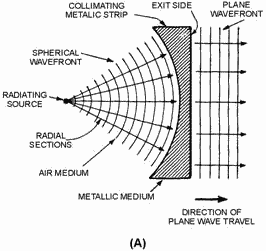Module 11 - Microwave Principles |
||||||||||||||||||||||||||||||||||||||||||||||||||
|
Module 11 − Microwave Principles
Pages i, 1−1, 1−11, 1−21, 1−31, 1−41, 1−51, 1−61, 2−1, 2−11, 2−21, 2−31, 2−41, 2−51, 2−61, 3−1, 3−11, AI−1, Index−1, Assignment 1, Assignment 2
Chapter 3 Microwave Antennas Learning Objectives Upon completion of this section the student will be able to: 1. Explain the basic characteristics of coupling, directivity, reciprocity, and efficiency in microwave antennas. 2. Describe the construction and basic theory of operation of reflector antennas and horn radiators. 3. Explain construction and operation of microwave lens antennas. 4. Describe the construction and theory of operation of driven and parasitic antenna arrays. 5. Explain the basic operation and applications of frequency-sensitive antennas. Introduction In this chapter you will study the general characteristics of microwave antennas that are widely used in radar and communications applications. The basic principles of operation of microwave antennas are similar to those of antennas used at lower frequencies. You might want to review the principles presented in NEETS, Module 10, Introduction to Wave Propagation, Transmission Lines, and Antennas, at this time. Pay particular attention to basic antenna principles in chapter 4 for a review of microwave antennas. Antennas are devices used to radiate electromagnetic energy into space. The characteristics of transmitting and receiving antennas are similar, so a good transmitting antenna is often a good receiving antenna. a single antenna performs both functions in many modern applications. Antenna Characteristics Since the operating principles of low-frequency and microwave antennas are essentially the same, the electrical characteristics are also very similar. You will need a fundamental knowledge of radar and communications antenna electrical theory in your shipboard antenna maintenance work. Antenna theory is primarily a design consideration of antenna size and shape requirements that depend on the frequency used. a brief description of antenna electrical characteristics is sufficient for the needs of most students of electronics. Antenna Efficiency The effectiveness of an antenna depends upon its ability to couple or radiate energy into the air. An efficient antenna is one which wastes very little energy during the radiation process. The efficiency of an antenna is usually referred to as the Power Gain or Power RATIO as compared to a standard reference antenna. The power gain of an antenna is a ratio of the radiated power to that of the reference antenna, which is usually a basic dipole. Both antennas must be fed RF energy in the same manner and must be in the same position when the energy is radiated. The power gain of a single dipole without a reflector is unity (one). An array of several dipoles in the same position as the single dipole, and fed with the same line, has a power gain of more than one. 3-1 The effectiveness of an entire transmitting/ receiving system depends largely on impedance matching between the elements of the system. Impedance matching is particularly critical at the antenna connection. If a good impedance match is maintained between the system and the antenna throughout the operating frequency band, power transfer to and from the antenna is always maximum. The transmission line or waveguide used to transport energy to and from the antenna should have a characteristic impedance equal to that of the antenna. a proper impedance match allows all available power to be absorbed and radiated by the antenna without reflections back down the line. If you have a transmission line or waveguide with an impedance mismatch at the termination, standing waves are set up by the reflections. Standing waves cause losses in the form of unwanted radiations, heat losses in transmission lines, and arcing in waveguides. The Standing-WAVE RATIO, abbreviated SWR, is a way to measure the degree of mismatch between the transmission line and its load. The SWR can be expressed as a ratio of the maximum and minimum values of the current or voltage in the standing waves that are set up on the lines as follows:
A transmission line or waveguide approaches a perfectly matched condition when the SWR approaches a value of 1. a ratio that is a little higher than 1 is usually acceptable in practical applications. Measurement of SWR is the only practical method of detecting an impedance mismatch between a transmitting/receiving system and its antenna. As such, the system SWR is an important indication of the overall efficiency of the system during operation. The line impedance can usually be matched to the antenna at only one frequency. However, the SWR will NOT become too high if the antenna is used over a small range of frequencies and the line is matched to the center frequency. Antenna Directivity You can divide antennas into two general classes based on directivity, omnidirectional and directional. OMNIDirectIONAL antennas radiate and receive energy from all directions at once (SPHERICAL WAVEFRONT). They are seldom used in modern radar systems as the primary antenna, but are commonly used in radio equipment and iff (identification friend or foe) receivers. DirectIONAL antennas radiate energy in LOBES (or BEAMS) that extend outward from the antenna in either one or two directions. The radiation pattern contains small minor lobes, but these lobes are weak and normally have little effect on the main radiation pattern. Directional antennas also receive energy efficiently from only one or two directions, depending upon whether it is unidirectional or bidirectional. Directional antennas have two characteristics that are important to you in radar and communications systems. One is DirectIVITY and the other is Power Gain. The directivity of an antenna refers to the NARROWNESS of the radiated beam. If the beam is NARROW in either the horizontal or vertical plane, the antenna has a high degree of directivity in that plane. An antenna may be designed for high directivity in one plane only or in both planes, depending on the application. The power gain of an 3-2 antenna increases as the degree of directivity increases because the power is concentrated into a narrow beam and less power is required to cover the same distance. Since microwave antennas are predominantly unidirectional, the examples you will study in this chapter are all of the unidirectional type. Reciprocity You read in this chapter that an antenna is able to both transmit and receive electromagnetic energy. This is known as RECIPROCITY. Antenna reciprocity is possible because antenna characteristics are essentially the same regardless of whether an antenna is transmitting or receiving electromagnetic energy. Reciprocity allows most radar and communications systems to operate with only one antenna. An automatic switch, called a DUPLEXER, connects either the transmitter or the receiver to the antenna at the proper time. Duplexer operation will be explained in later NEETS modules dealing with radar and communications systems. Because of the reciprocity of antennas, this chapter will discuss antennas from the viewpoint of the transmitting cycle. However, you should understand that the same principles apply on the receiving cycle. Radar Fundamentals Radio, television, radar, and the human eye have much in common because they all process the same type of electromagnetic energy. The major difference between the light processed by the human eye and the radio-frequency energy processed by radio and radar is frequency. For example, radio transmitters send out signals in all directions. These signals can be detected by receivers tuned to the same frequency. Radar works somewhat differently because it uses reflected energy (echo) instead of directly transmitted energy. The echo, as it relates to sound, is a familiar concept to most of us. An experienced person can estimate the distance and general direction of an object causing a sound echo. Radar uses microwave electromagnetic energy in much the same way. Radar transmits microwave energy that reflects off an object and returns to the radar. The returned portion of the energy is called an ECHO, as it is in sound terminology. It is used to determine the direction and distance of the object causing the reflection. Determination of direction and distance to an object is the primary function of most radar systems. Telescopes and radars, in terms of locating objects in space, have many common problems. Both have a limited field of view and both require a geographic reference system to describe the position of an object (target). The position of an object viewed with a telescope is usually described by relating it to a familiar object with a known position. Radar uses a standard system of reference coordinates to describe the position of an object in relation to the position of the radar. Normally ANGULAR measurements are made from true north in an imaginary flat plane called the HORIZONTAL Plane. All angles in the UP direction are measured in a second imaginary plane perpendicular to the horizontal plane called the VERTICAL Plane. The center of the coordinate system is the radar location. As shown in figure 3-1, the target position with respect to the radar is defined as 60 degrees true, 10 degrees up, and 10 miles distant. The line directly from the radar to the target is called the LINE of SIGHT. The distance from point 1 to point 2, measured along the line of sight, is called TARGET RANGE. The angle between the horizontal plane and the line of sight is known as the ELEVATION ANGLE. The angle measured in a clockwise direction in the horizontal plane between true north and the line of sight is known as BEARING (sometimes referred to as AZIMUTH). These three coordinates of range, bearing, and elevation determine the location of the target with respect to the radar. 3-3
Figure 3-1. - Radar target position.
Bearing and elevation angles are determined by measuring the angular position of the radar antenna (the transmitted beam) when it is pointing directly at the target. Range is more difficult to determine because it cannot be directly measured. The radar system is designed to measure range as a function of time. Since the speed of electromagnetic energy is the same as the speed of light, range is determined by measuring the time required for a pulse of energy to reach the target and return to the radar. Because the speed of the pulse is known, the two-way distance can be determined by multiplying the time by the speed of travel. The total must be divided by two to obtain the one-way range because the time value used initially is the time required for the pulse to travel to the target and return. The discussion of microwave antennas in this chapter requires only the most basic understanding of radar concepts! Radar fundamentals will be discussed in more detail in a later NEETS module.
Q-1. Microwave antennas and low-frequency antennas are similar in what ways?
Q-2. What term is used to express the efficiency of an antenna?
Q-3. What term is used to express the measurement of the degree of mismatch between a line and its load?
Q-4. What type of antenna radiates in and receives energy from all directions at once?
Q-5. What is the term that is used to describe narrowness in the radiated beam of an antenna?
Q-6. What characteristic allows the same antenna to both transmit and receive? 3-4 Reflector Antennas A spherical wavefront (one in which the energy spreads out in all directions) spreads out as it travels away from the antenna and produces a pattern that is not very directional. a wavefront that exists in only one plane does not spread because all of the wavefront moves forward in the same direction. For an antenna to be highly directive, it must change the normally spherical wavefront into a plane wavefront. Many highly directive microwave antennas produce a plane wavefront by using a reflector to focus the radiated energy. The PARABOLIC Reflector is most often used for high directivity. Microwaves travel in straight lines as do light rays. They can also be focused and reflected just as light rays can, as illustrated by the antenna shown in figure 3-2. a microwave source is placed at focal point F. The field leaves this antenna as a spherical wavefront. As each part of the wavefront reaches the reflecting surface, it is phase-shifted 180 degrees. Each part is then sent outward at an angle that results in all parts of the field traveling in parallel paths. Because of the special shape of a parabolic surface, all paths from F to the reflector and back to line XY are the same length. Therefore, when the parts of the field are reflected from the parabolic surface, they travel to line XY in the same amount of time.
Figure 3-2. - Parabolic reflector radiation.
If a dipole is used as the source of transmission, energy will be radiated from the antenna into space as well as toward the reflector. Energy which is not directed toward the paraboloid has a wide-beam characteristic which will destroy the narrow pattern of the parabolic reflector. However, a HEMIsPHERICAL SHIELD (not shown) may be used to direct most of the radiation toward the parabolic surface and thus prevent the destruction of the narrow pattern. Direct radiation into space is eliminated, the beam is made sharper, and more power is concentrated in the beam. Without the shield, some of the radiated field would leave the radiator directly. Since this part of the field that would leave the radiator would not be reflected, it would not become a part of the main beam and could serve no useful purpose. In figure 3-3 the radiation pattern of a paraboloid reflector contains a major lobe and several minor lobes. The major lobe is directed along the axis of revolution. Very narrow beams are possible with this type of reflector. Figure 3-4 illustrates the basic paraboloid reflector. 3-5
Figure 3-3. - Parabolic radiation pattern.
Figure 3-4. - Basic paraboloid reflector.
You may see several variations of the basic paraboloid reflector used to produce different beam shapes required by special applications. The basic characteristics of the most commonly used paraboloids are presented in the following paragraphs. Truncated Paraboloid Figure 3-5A, shows a TRUNCATED PARABOLOID. Since the reflector is parabolic in the horizontal plane, the energy is focused into a narrow beam. With the reflector TRUNCATED (cut) so that it is shortened vertically, the beam spreads out vertically instead of being focused. This fan-shaped beam is used in radar detection applications for the accurate determination of bearing. Since the beam is spread vertically, it will detect aircraft at different altitudes without changing the tilt of the antenna. The truncated paraboloid also works well for surface search radar applications to compensate for the pitch and roll of the ship. 3-6
Figure 3-5A. - Truncated paraboloid.
The truncated paraboloid may be used in target height-finding systems if the reflector is rotated 90 degrees, as shown in figure 3-5B. Since the reflector is now parabolic in the vertical plane, the energy is focused vertically into a narrow beam. If the reflector is truncated, or cut, so that it is shortened horizontally, the beam will spread out horizontally instead of being focused. Such a fan-shaped beam is used to accurately determine elevation.
Figure 3-5B. - Truncated paraboloid. Orange-Peel Paraboloid A section of a complete circular paraboloid, often called an ORANGE-PEEL Reflector because of its orange-peel shape, is shown in figure 3-6. Since the reflector is narrow in the horizontal plane and wide in the vertical plane, it produces a beam that is wide in the horizontal plane and narrow in the vertical plane. In shape, the beam resembles a huge beaver tail. The microwave energy is sent into the parabolic reflector by a horn radiator (not shown) which is fed by a waveguide. The horn radiation pattern covers nearly the entire shape of the reflector, so almost all of the microwave energy strikes the reflector and very little escapes at the sides. Antenna systems which use orange-peel paraboloids are often used in height-finding equipment. 3-7
Figure 3-6. - Orange-peel paraboloid. Cylindrical Paraboloid When a beam of radiated energy that is noticeably wider in one cross-sectional dimension than in another is desired, a cylindrical paraboloidal section which approximates a rectangle can be used. Figure 3-7 illustrates such an antenna. a PARABOLIC CYLINDER has a parabolic cross section in just one dimension which causes the reflector to be directive in one plane only. The cylindrical paraboloid reflector is fed either by a linear array of dipoles, a slit in the side of a waveguide, or by a thin waveguide radiator. It also has a series of focal points forming a straight line rather than a single focal point. Placing the radiator, or radiators, along this focal line produces a directed beam of energy. As the width of the parabolic section is changed, different beam shapes are obtained. You may see this type of antenna system used in search radar systems and in ground control approach (gca) radar systems.
Figure 3-7. - Cylindrical paraboloid. Corner Reflector The CORNER-Reflector Antenna consists of two flat conducting sheets that meet at an angle to form a corner, as shown in figure 3-8. The corner reflector is normally driven by a Half-WAVE Radiator located on a line which bisects the angle formed by the sheet reflectors. 3-8
Figure 3-8. - Corner reflector.
Q-7. What type of reflector is most often used in directive antennas?
Q-8. Microwaves can be focused and reflected in the same way as what other type of waves?
Q-9. How many major lobes are radiated by a parabolic reflector?
Q-10. a horizontally truncated paraboloid antenna is used for what purpose?
Q-11. The beam from a horizontally positioned cylindrical paraboloid is narrow in what plane?
HORN Radiators Like parabolic reflectors, you can use HORN Radiators to obtain directive radiation at microwave frequencies. Because they do not use resonant elements, horns have the advantage of being useful over a wide frequency band. The operation of a horn as an RF radiating device is similar to that of an automobile horn radiating sound waves. However, the throat of an automobile horn usually is sized much smaller than the sound wavelengths for which it is used. The throat of the RF radiating horn is sized to be comparable to the wavelength being used. Horn radiators are used with waveguides because they serve both as an impedance-matching device and as a directional radiator. Horn radiators may be fed by coaxial and other types of lines. Horn radiators are constructed in a variety of shapes, as illustrated in figure 3-9. The shape of the horn determines the shape of the field pattern. The ratio of the horn length to the size of its mouth determines the beam angle and directivity. In general, the larger the mouth of the horn, the more directive is the field pattern.
Figure 3-9. - Horn radiators.
3-9 LENS Antennas With a LENS Antenna you can convert spherically radiated microwave energy into a plane wave (in a given direction) by using a point source (open end of the waveguide) with a COLLIMATING LENS. a collimating lens forces all radial segments of the spherical wavefront into parallel paths. The point source can be regarded as a gun which shoots the microwave energy toward the lens. The point source is often a horn radiator or a simple dipole antenna. Waveguide Type The WAVEGUIDE-TYPE LENS is sometimes referred to as a conducting-type. It consists of several parallel concave metallic strips which are placed parallel to the electric field of the radiated energy fed to the lens, as shown in figure 3-10A and 3-10B. These strips act as waveguides in parallel for the incident (radiated) wave. The strips are placed slightly more than a half wavelength apart.
Figure 3-10A. - Waveguide lens.
3-10
|
||||||||||||||||||||||||||||||||||||||||||||||||||

